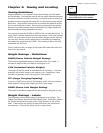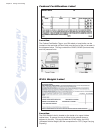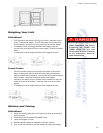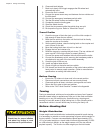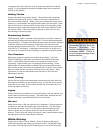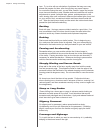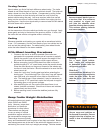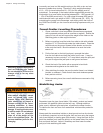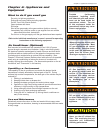
16
Chapter 3: Towing and Leveling
lane. Try to drive with an anticipation of problems that may occur way
ahead and prepare for them, even though they may never happen.
As a motorist sharing the road, you are taller, heavier, longer and require
more time and distance to stop. Weather and road conditions will require
adjustments to speed. Anticipate dips, gutters, and depressions in the
road, slowing down well in advance, these are the hardest jolts of any kind
on your vehicle, hitch, recreational vehicle and items stored inside the
unit. Take dips and bumps slowly and be certain the trailer wheels have
passed the point before accelerating.
Backing
Back with care. Having a person outside to assist is a good idea. If no
one is available to help, the driver should inspect the area behind the
vehicle to avoid any unseen obstacles and unpleasant surprises.
Braking
Start sooner and lead with your trailer brakes. Prior to beginning any
trip, make sure the brake control is adjusted. See your accompanying
literature for the brake control you had purchased for your tow vehicle.
Passing and Accelerating
Remember when you pass another vehicle that it takes longer to
accelerate and additional time must be allowed due to the added length
of the trailer. Passing should be done on level terrain and downshift, if
necessary for added acceleration. Whenever deciding to pass another
vehicle, exercise caution and always use the turn signals.
Sharply Winding and Narrow Roads
Keep well to the center of the lane, equally away from both the center
line and pavement edge. This allows the trailer to clear the edge of the
pavement without the likelihood of the wheels dropping onto the shoulder,
causing potential dangerous sway. Do not overcrowd or cross the center
line.
All sharp turns should be taken at low speeds. Professional drivers,
when rounding turns, slow down well in advance of the turn, entering it at
reduced speed, and then accelerate smoothly as they come out again into
the straightaway.
Steep or Long Grades
Down shifting into a lower gear or range in advance assists braking on
descents and adds power on the climb. Avoid situations that require
excessive and prolonged use of the brakes. Apply and release brakes at
short intervals to give them a chance to cool.
Slippery Pavement
On slippery and icy pavement, reduce speed and drive slowly.
Hydroplaning can occur with little water on the pavement. If skidding
begins, remove your foot from the throttle and gently apply the trailer
brakes only.
Freeways and Highways
Try to pick the lane in which you want to move and stay in it, preferably
keeping to the slower lane on the right.



